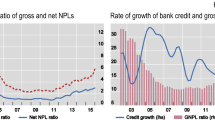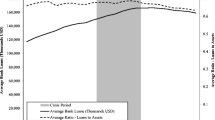Abstract
The Federal Home Loan Bank system (FHLB) has evolved into a major source of liquidity for the banking system with the demonstrated ability to borrow over a trillion dollars in world financial markets based on an implied U. S. Treasury guarantee. The FHLB loans the borrowed funds to commercial banks at reduced rates that are not adjusted for the risk of an individual bank. Moral hazard could cause member banks using FHLB loans to increase financial leverage and exposure to high risk assets. Conversely, the FHLB offers banks additional liquidity and specialized debt instruments that help them manage interest rate risk. We use dynamic panel generalized method of moments estimation to test the relation between FHLB advances and bank risk. We find that if banks have relatively normal default probabilities, advances are not associated with increased bank risk but, instead, advances are related to decreased interest rate risk. However, when bank default probabilities are high, our evidence suggests advances and higher bank risk are related.
Similar content being viewed by others
Notes
The number of lags varies by risk measure based on the results of pre-tests discussed in Section 4.4. We include 5 lags of most dependent variables. The two exceptions are commercial real estate loans and risk-based capital ratio in which we use 4 lags and 3 lags respectively.
The methodology suggested by Han and Phillips (2010) is only necessary when the dynamic panel autoregressive coefficient (ρ) approaches unity. Otherwise system dynamic panel GMM produces consistent estimators. We test if ρ = 1, and we are able to reject that ρ = 1 at better than the 1 % level for each variable in our study.
Complete results of the tests are available from the authors.
This is in contrast to unreported fixed-effects results in which half of the risk measures are significantly related to advance usage. This illustrates the point made by Wintoki, Linck, and Netter (2012) that ignoring the dynamic relation between variables can induce bias and lead to erroneous conclusions.
The Federal Deposit Insurance Corporation delineates two classes of large banks. One group is composed of the banks over one billion dollars in assets and the other group is banks over ten billion dollars. We believe the ten billion dollar break better reveals the performance disparities between large and small banks. However, the empirical results are essentially the same with either split.
The relatively large coefficient on advances can be expected based on the combination of two factors. First, the coefficient on advances is large in all risk based capital regressions, even when insignificant. Second, capital is known to be important for bank safety (for example, Berger and Bouwman (2013)) and the non-failed banks are relatively safer than the failed banks. It is therefore not surprising to find a strong relation between advances and capital in this subsample.
We do not interpret these results to mean that banks in general are gambling with advances. We do find evidence of increased risk for banks closer to the default boundary. Anecdotal evidence suggests that a few banks borrowed heavily from the FHLB as they were fighting for survival, e.g. Washington Mutual Bank, Countrywide Federal Savings Bank, and IndyMac.
References
Arellano M, Bond S (1991) Some tests of specification for panel data: Monte Carlo evidence and application to employment equations. Rev Econ Stud 58:277–297
Arellano M, Bover O (1995) Another look at the instrumental variable estimation of error-component models. J Econ 68:29–51
Ashcraft A, Bech M, Frame W (2010) The Federal Home Loan Bank system: the lender of next-to-last resort? J Money Credit Bank 42:551–583
Ashley L, Brewer E, Vincent N (1998) Access to FHLBank advances and the performance of thrift institutions. Econ Perspect Fed Reserv Bank of Chic 2:33–52
Berger A, Bouwman C (2013) How does capital affect bank performance during financial crisis? J Financ Econ 109:146–176
Billett M, Garfinkel J, O’Neal E (1998) The cost of market versus regulatory discipline in banking. J Financ Econ 48:333–358
Blundell R, Bond S (1998) Initial conditions and moment restrictions in dynamic panel data models. J Econ 87:115–143
Blundell R, Bond S, Windmeijer R (2000) Estimation in dynamic panel data models: improving on the performance of the standard GMM estimator. In: Baltagi B (ed) Nonstationary panels, panel cointegration, and dynamic panels: advances in econometrics, vol 15. Elsevier Science, Amsterdam
Board of Governors of the Federal Reserve System (2008) Factors affecting reserve balances of depository institutions and condition statement of the Federal Reserve Banks
Han C, Phillips P (2010) GMM estimation for dynamic panels with fixed effects and strong instruments at unity. Econ Theory 26:119–151
Holtz-Eakin D, Newey W, Rosen H (1988) Estimating vector auto-regressions with panel data. Econometrica 56:1317–1395
Keeley M (1990) Deposit insurance, risk and market power in banking. Am Econ Rev 80:1183–1200
Merton R (1977) An analytic derivation of the cost of deposit insurance loan guarantees. J Bank Financ 1:3–11
Office of Finance of the Federal Home Loan Banks (2008, 2010, and 2011) Federal Home Loan Banks combined financial reports
Scott J, Hein S (2011) The Federal Home Loan Bank System: a government sponsored enterprise that avoided conservatorship. J Appl Financ 21:44–61
Stojanovic D, Vaughan M, Yeager T (2008) Do Federal Home Loan Bank membership and advances increase bank risk-taking? J Bank Financ 32:680–698
Wintoki M, Linck J, Netter J (2012) Endogeneity and the dynamics of internal corporate governance. J Financ Econ 105:581–606
Author information
Authors and Affiliations
Corresponding author
Rights and permissions
About this article
Cite this article
Davidson, T., Simpson, W.G. Federal Home Loan Bank advances and bank risk. J Econ Finan 40, 137–156 (2016). https://doi.org/10.1007/s12197-014-9300-8
Published:
Issue Date:
DOI: https://doi.org/10.1007/s12197-014-9300-8




